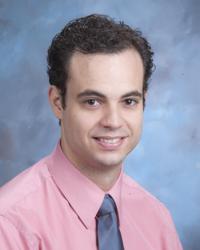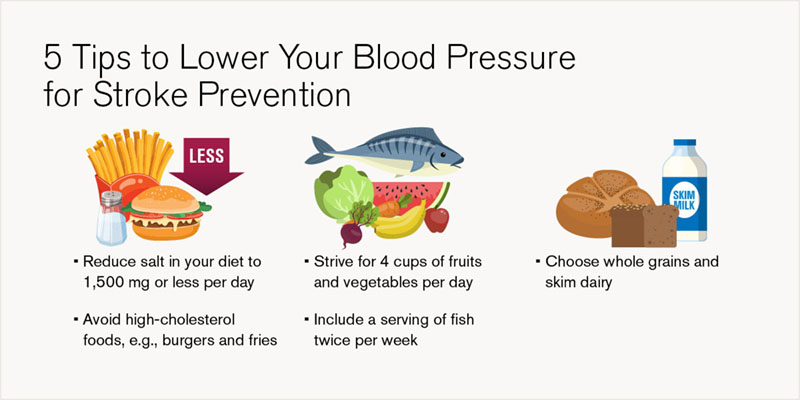
According to the Centers for Disease Control, every 40 seconds someone in the United States has a stroke. Despite this dire statistic, there are many lifestyle changes you can make to minimize your risk of stroke, regardless of your genetic predisposition or family history.
Loyola Medicine neurologist Sarkis Morales Vidal, MD has clinical expertise in hemorrhagic strokes, aneurysms, and many other neurological conditions. "Strokes are among the 10 most common causes of death in the United States," he says. "However, there are modifiable risk factors that can be fixed to lower the risk."
What is a stroke?
A stroke occurs when blood flow to a part of the brain becomes impaired, damaging or killing cells. This can lead to long-term problems, including:
- Memory issues or trouble speaking
- Vision issues
- Difficulty walking or keeping balance
- Paralysis of parts of the body
- Trouble swallowing
- Difficulty controlling going to the bathroom
There are actually two types of strokes: ischemic and hemorrhagic.
An ischemic stroke is the most common type, occurring when blood clots or other particles, like plaque, build in a part of the brain, blocking blood vessels. A hemorrhagic stroke happens when an artery in the brain leaks or ruptures, putting too much pressure on the brain, damaging cells.
What are the symptoms of a stroke?
Most strokes happen suddenly, with little warning. However, they can also occur over hours or even days. This is why it's important to recognize the signs, including:
- Sudden, severe headache
- Difficulty seeing out of one or both eyes
- Confusion, trouble speaking or understanding
- Sudden dizziness or loss of balance
- Numbness of weakness in the face or extremities, especially on one side of the body
An easy acronym to help you remember the most common symptoms of a stroke is B.E. F.A.S.T.:
- B (balance)
- E (eyes; blurred or double vision)
- F (face drooping)
- A (arm weakness)
- S (speech trouble)
- T (time to call 911)
If you or someone else shows symptoms of a stroke, call 911 immediately. The chances of survival increase dramatically if emergency treatment is provided within 3 hours.
How to prevent a stroke
While some factors are out of your control when it comes to lowering stroke risk, there are many actions you can take immediately to minimize the risk of stroke.
Lower blood pressure
Lowering your blood pressure is the most impactful way to minimize the risk of stroke. High blood pressure is arguably the biggest risk factor of strokes – especially hemorrhagic strokes where pressure can cause an artery to rupture – doubling or even quadrupling stroke risk if not controlled.
"One of the more objective ways to really prevent stroke is to control your blood pressure," says Dr. Vidal. "You can measure your blood pressure at home. While optimal blood pressure is less than 120/80, any decrease in these numbers is a win. Exercising and eating healthier will directly impact your blood pressure and minimize your stroke risk."

Lose excess weight
Obesity increases the likelihood from having a stroke due to the complications linked to it, such as high blood pressure and diabetes. This isn't to say that you need to lose 100 pounds to achieve success. Dropping 10 pounds can be a significant improvement in stroke risk.
"Regular physical activity will obviously prevent strokes, as well as a healthy diet," says Dr. Vidal. "There are certain diets, like the Mediterranean diet, that the American Heart Association has published data on, showing that it can help maintain proper weight."
An ideal body mass index (BMI) is 20 to 25, although this number may not be realistic for you. "BMI, or basic metabolic index, can be a helpful guide. However, speak with your health care provider as they can provide greater context to BMI and help you on your weight loss journey," says Dr. Vidal.
Here are two ways that can help you lose weight:
- Increase your amount of physical activity. While the recommended amount is 150 minutes per week of moderately intense activity, including 2 days per week of muscle strengthening, any increase in exercise is meaningful.
- Eat a dietary pattern that emphasizes a wide variety of fruits and vegetables, whole grains, and healthy sources of protein.
Quit smoking
Smoking speeds up the formation of clots by thickening your blood and increasing the amount of plaque buildup in arteries. Alongside lowering your blood pressure and losing weight, quitting smoking is one of the biggest ways in which you can reduce your stroke risk.
"When it comes to controlling risk factors, not smoking is a big one," says Dr. Vidal. "If you feel like you can't quit smoking on your own, talk with your health care provider who can provides options to help you quit."
It's important to know that even if you try to quit and fail several times, not giving up is the key to success. Many smokers can quit only after several attempts. Any reduction in your daily cigarette count is beneficial to your health, and an important step in your journey to quit smoking.
Stroke risk factors you can't change
Stroke can impact anyone at any age. However, people are predisposed to a higher risk of stroke due to factors they can't control, such as age, family history, race, sex, geography, and history of prior strokes.
"In terms of risk factors you can't control, family history can have an impact," says Dr. Vidal. "There are some genetic causes of stroke. However, these genetic mutations are not common. Also, race is a factor. African-Americans have a much higher risk for death and disability from stroke. Age is another one where the elderly - 60 years old and older - have a much higher risk of stroke than a healthy individual in their 20s. Even extreme temperatures can be a risk factor."
However, it's important to note that lifestyle changes have a much bigger impact on reducing stroke risk.
"Risk factors are very individualized so patients should see their primary doctor to understand their risk," says Dr. Vidal. "For example, while an older person has a higher risk of stroke in general, a young person who doesn't eat well or exercise is also at risk. It's important to understand your risk factors and make lifestyle changes before a stroke occurs. Once someone has one stroke, they are much more likely to incur another."
Loyola primary and specialty care offices are conveniently located throughout Chicago’s western and southwestern suburbs. The neurology department at Loyola Medicine has one of the most comprehensive and advanced teams in the nation. Through collaboration with subspecialty physician, the neurosurgery team provides exceptional comprehensive care.
To make an appointment, call 888-584-7888 or schedule an appointment online.
Sarkis Morales Vidal, MD is a neurologist at Loyola Medicine. Dr. Vidal received his medical degree from Universidad Central del Este (East Central University) in the Dominican Republic before completing his residency and fellowship at Loyola University Stritch School of Medicine.
Dr. Vidal specializes in critical care and treating people who have suffered from strokes and other neurological conditions. His research includes the management of blood pressure in stroke victims and neurologic complications in athletes.
Book an appointment today to see Dr. Vidal or another Loyola neurologist by self-scheduling an in-person or virtual appointment using myLoyola.

